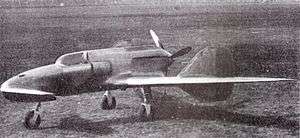Ambrosini SS.4
| SS.4 | |
|---|---|
 | |
| The Ambrosini SS.4 | |
| Role | Fighter |
| Manufacturer | SAI-Ambrosini |
| Designer | Sergio Stefanutti[1] |
| First flight | 7 March 1939 |
| Number built | 1 |
The SAI-Ambrosini SS.4 was an Italian fighter prototype developed in the late 1930s, featuring a canard-style wing layout and a 'pusher' propeller. Development of the SS.4 was abandoned after the prototype crashed on its second flight.[1]
Development
Sergio Stefanutti had already experimented with canard aircraft with the S.C.A. SS.2 and S.C.A. SS.3 Anitra ("Duck"), light aircraft built by Stabilimento Costruzioni Aeronautiche (SCA) at Guidonia (a new city focused on aviation). The single-seat SS.2 had a canard wing configuration, fixed undercarriage and was powered with a 2-cylinder Keller engine rated at 16 hp (11.93 kW). The SS.2 first flew in 1935, and one of the two prototypes was converted into a two-seater with a larger 38 hp (28.34 kW) CNA II engine built by Compagnia Nazionale Aeronautica. This new aircraft first took to the air on 2 October 1937 and was officially revealed in Milan at an international air exposition and the small fixed-undercarriage SS.2 was sent to Passignano for evaluation. Experience with this machine and the study of its aerodynamics led Stefanutti to design a canard style interceptor and air superiority fighter, designated SS.4, very similar in layout to the SS.2 and SS.3.[1]
The SS.3 had a span of 12.77 m (41.9 ft) and was 6.00 m (19.7 ft) long with an overall height of 2.01 m (6.6 ft). With a 16 hp (12 kW) engine it was capable of a maximum speed of 87 mph (140 km/h) and able to reach an altitude of 13,120 ft (4,000 m) altitude. Stalling speed was 34 mph (55 km/h):[1]
A prototype SS.4 was built at the Società Aeronautica Italiana - Ambrosini factory in Passignano sul Trasimeno, Umbria. Relatively little flying was carried out as development of the SS.4 was abandoned after the prototype crashed, killing the test pilot. The design barely compared favourably to contemporary fighters, and the Regia Aeronautica decided not to pursue the design, despite having already ordered a second aircraft which was cancelled.[1]
Design
The SS.4 was a single-seat fighter of all-metal construction with a canard configuration wing with twin fins mounted on the wing trailing edges, retractable tricycle undercarriage and short fuselage with rear-mounted engine driving a pusher propeller.[1]
The pilot was accommodated in an enclosed cockpit in the centre of the fuselage forward of the two fuel tanks and aft of the armament in the nose. Visibility from the cockpit was excellent to the sides and front, but restricted to the rear by the large main wing, engine and large twin fins positioned at approximately the half-span position. Flying controls consisted of elevators on the trailing edges of the canard fore-plane controlling pitch, rudders on the large fins controlling yaw and ailerons on the main wings to control roll. Pitch trim was set by adjusting a trim tab on the starboard elevator.[1]
The moderately swept, tapered, high aspect ratio wings had no sweep on the trailing edge and a cut back to give clearance for the propeller, with the large fins with rudders extending past the trailing edge at the ends of the cut-backs, to ensure enough moment to give adequate control and stability. The delta fore-plane was of low aspect ratio with the elevators sited below the trailing ege similar to the method used by contemporary Junkers aircraft like the Junkers Ju 87.[1]
The engine was a powerful liquid-cooled Isotta-Fraschini Asso XI R.C.40 engine capable of 960 hp (720 kW) driving a three-bladed metal propeller. The engine was cooled by two radiators either side of the fuselage in ducts just behind the cockpit. Fuel for the engine was housed in two fuel tanks located mid-fuselage along with an oil tank.[1]
Armament was to be two 20 mm (0.787 in) cannon and one 30 mm (1.181 in) cannon, clustered in the nose.[1]
Operational history
The prototype SS.4 was built by SAI Ambrosini, Passignano sul Trasimeno, and then sent to Eleuteri airport, Castiglione del Lago, also in the Trasimeno area. There, the aircraft was successfully flown for the first time on 7 March 1939. The next day the SS.4 prototype was scheduled to be transported to Aviano airbase by rail, but Ambrosini's chief test pilot Ambrogio Colombo wanted a second test flight. After 45 minutes, an aileron malfunctioned just 2 km (1.2 mi) from Eleuteri. Colombo attempted to land but was unable to reach the runway and crashed near Campagna, hitting a tree.[1] Colombo was killed when the engine pushed through the rear bulkhead and crushed him against the front of the cockpit. A memorial to him was erected near the site of the crash. The investigation into the crash concluded that the accident was due to imperfect construction which led to a faulty installation of the aileron which had failed. The study also pointed out the excessive vibrations transmitted by the engine to the wing.[2]

Specifications (SS.4)
Data from Italian Civil and Military Aircraft 1930-1945[1]
General characteristics
- Crew: 1
- Length: 6.74 m (22 ft 1 in) [2]
- Wingspan: 12.32 m (40 ft 5 in)
- Height: 2.49 m (8 ft 2 in)
- Wing area: 17.5 m2 (188 sq ft) [2]
- Gross weight: 2,449 kg (5,400 lb)
- Powerplant: 1 × Isotta-Fraschini Asso XI R.C.40 V-12 liquid-cooled piston engine, 720 kW (960 hp)
- Propellers: 3-bladed metal pusher propeller
Performance
- Maximum speed: 571 km/h; 308 kn (355 mph)
- Stall speed: 110 km/h (68 mph; 59 kn) [2]
See also
- Aircraft of comparable role, configuration and era
- Kyushu J7W
- Saab 21
- Curtiss XP-55 Ascender
- Northrop XP-56 Black Bullet
- Vultee XP-54 Swoose Goose
- Miles Libellula
References
| Wikimedia Commons has media related to Ambrosini aircraft. |
- Notes
- Bibliography